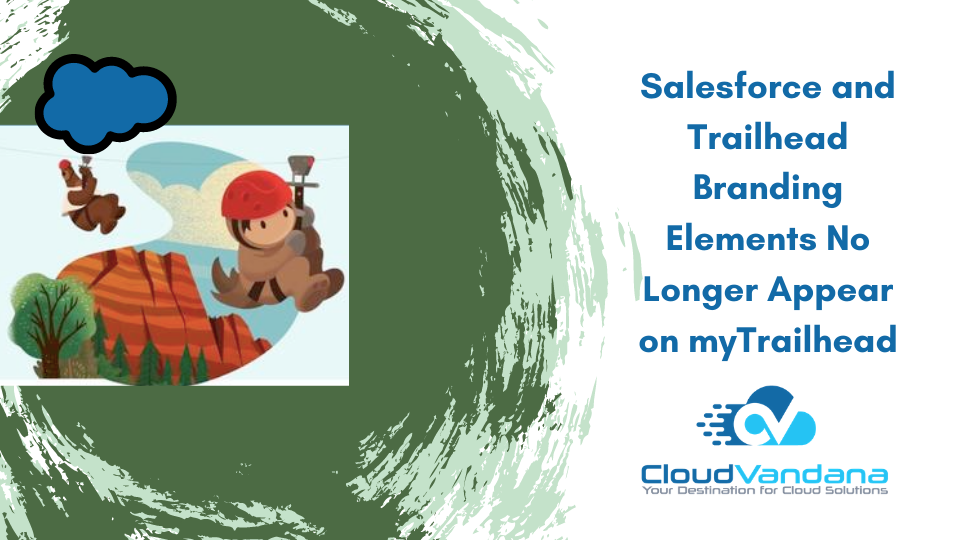Salesforce and Trailhead Branding Elements No Longer Appear on myTrailhead

Explore how the removal of Salesforce and Trailhead branding from myTrailhead affects user experience, customization, and corporate enablement strategies. Learn how to adapt and maintain learner engagement in a streamlined UI environment. Introduction: The Changing Face of myTrailhead Salesforce’s myTrailhead once stood as a beacon of fun, personalized learning—draped in bold, colorful branding, quirky mascots, and signature Trailhead identity. But over the past few months, something significant has shifted. The familiar Salesforce and Trailhead branding elements are quietly disappearing from myTrailhead instances across organizations. For system admins, enablement leaders, and UX strategists, this subtle visual evolution is more than a cosmetic change—it’s a paradigm shift that could influence learner engagement, corporate identity, and how Salesforce positions its enablement ecosystem. Understanding myTrailhead: A Quick Recap myTrailhead is Salesforce’s white-labeled learning experience platform built on the same technology as Trailhead. It enables companies to create customized training paths, publish internal enablement content, and gamify learning within the Salesforce ecosystem. myTrailhead offered the same look and feel as public Trailhead, complete with badges, characters, and celebratory animations—but with the ability to replace those elements with company-specific branding. The Original Branding DNA of Trailhead The Trailhead experience has always leaned heavily on visual identity. From Astro and Codey to glittering badge trails and forest-themed layouts, the platform combined education with playful branding. This branding created a unique, recognizable environment that users loved. For myTrailhead, some of this charm was optionally replaceable—yet the underlying aesthetic, mascot icons, and subtle UI touches persisted unless intentionally overridden. Branding Elements That Have Now Disappeared In recent updates, users and administrators began noticing that certain elements no longer appear in myTrailhead: When Did the Change Begin? This shift began rolling out silently across various orgs. While no major announcements were made in release notes, several community-led discussions began surfacing highlighting the missing elements. Official Communications (or Lack Thereof) To date, Salesforce has not made a direct public announcement about retiring these branding elements. Admins who filed support tickets were pointed to UI unification and design standardization policies—but there was no detailed roadmap or public-facing blog acknowledging the decision. Why Salesforce May Have Chosen to Retire Branding There are several strategic reasons behind the decision: Implications for Organizations Using myTrailhead Without Trailhead branding, some companies may feel the platform loses its motivational spark. This could affect: Internal enablement teams may need to adapt by increasing their own branding efforts or finding third-party tools to recreate a rich UX. Impact on Customization and Theming While myTrailhead always offered limited customization, the loss of native branding means that admins must now: This adds complexity to the rollout and continuity of L&D initiatives. User Reactions and Community Discussions Salesforce Trailblazer Community threads show mixed reactions: UI vs. UX: The Delicate Balance The removal of branding has triggered a deeper conversation about the balance between clean interfaces and engaging user experiences. For many, visual storytelling was key to onboarding success. Without these cues, content may feel dry, transactional, or overly corporate. Comparing Classic Trailhead vs. Today’s myTrailhead A side-by-side comparison reveals: While some organizations appreciate the sleeker look, others miss the delightful quirks that made Trailhead unique. What Remains Intact on myTrailhead Despite visual changes, core platform features remain untouched: This ensures continuity in enablement efforts, even if the façade has shifted. Can Branding Be Brought Back Manually? Yes, to a degree. Admins can use: However, this requires developer intervention and lacks official support. The Role of Lightning Web Runtime in This Evolution Salesforce’s shift toward Lightning Web Runtime means less tolerance for legacy or themed UIs. Uniform components help reduce browser inconsistencies and deliver performance gains—but also strip away custom visual layers. How It Affects White-Label Use Cases Many companies used myTrailhead for customer onboarding or partner enablement. The removal of Salesforce branding could: For ISVs, it may offer more control but also more responsibility for engagement design. Trailhead GO and Mobile Branding Parity The Trailhead GO mobile app has followed a similar trajectory: This aligns the mobile and desktop experience under one unified design vision. Salesforce’s Broader UI Harmonization Goals This shift is part of a broader initiative: Evaluating the Trade-Off: Brand Charm vs. Standardization The central dilemma: is enterprise efficiency worth the loss of Trailhead’s visual identity? For some, standardization brings professionalism and speed. For others, it strips away the uniqueness that drove engagement in the first place. Should You Reconsider myTrailhead as a Learning Tool? Here’s a decision framework: Preparing for Further Visual Simplification Across Salesforce This may just be the beginning. As Salesforce moves further toward harmonized UI and AI-first design, expect: FAQs: Branding Changes in myTrailhead What exactly changed in myTrailhead’s branding? Salesforce removed several signature branding elements from myTrailhead, including mascots, logos, themed illustrations, and celebratory visuals. The UI has been simplified to align more closely with the Salesforce Lightning Design System. Can I still add custom branding to myTrailhead? Yes, but only partially. While official Trailhead visuals are no longer available, admins can use custom Lightning components, static resources, and illustrations to simulate a branded experience. Developer effort is typically required for full customization. Does this change affect learning functionality or just the appearance? Functionality remains unchanged. You can still build modules, assign trails, track progress, and gamify learning. Only the visual branding elements have been streamlined or removed. Staying Ahead in a Fluid Ecosystem Salesforce’s decision to remove Trailhead branding from myTrailhead reflects a broader trend toward UI standardization and platform efficiency. While it may feel like a loss in personality, it also presents an opportunity for organizations to double down on their own learning identity. As enablement leaders, the challenge lies in balancing platform evolution with user engagement—and leading that evolution with clarity and creativity. CloudVandana’s Perspective: Turning Branding Change into an Opportunity At CloudVandana, we don’t just keep up with Salesforce’s evolution—we help you get ahead of it. The recent changes to Trailhead branding present a powerful moment to redefine how your organization delivers learning experiences. Our Salesforce-certified consultants are experts in






